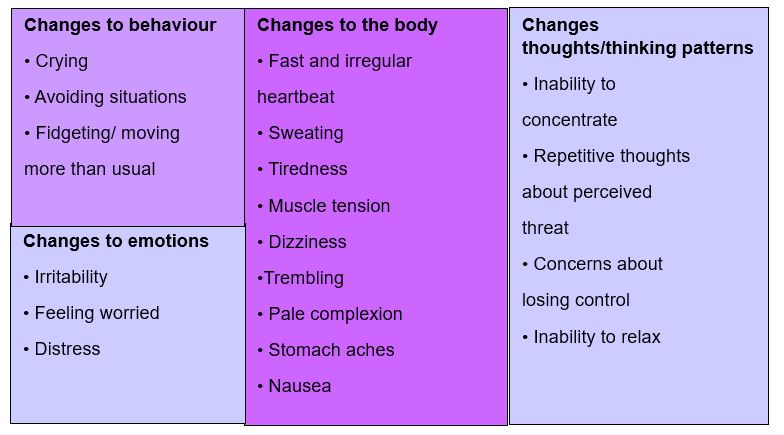What is Anxiety?
Anxiety and fear are our body’s built-in response to danger – our alarm system. When we are anxious or fearful our hearts beat faster, and blood is directed to our muscles so that we are ready to protect ourselves from the danger by either ‘fighting’ or ‘fleeing’. We experience ‘fear’ when we have to tackle an immediate threat (e.g. getting out of a burning house); however, anxiety is experienced when we anticipate that something threatening might happen in the future (i.e., going to a new school).
Signs of anxiety
There are many different signs that someone may be feeling anxious. These can be changes in the person’s body, thoughts, emotions and behaviour, and may differ between people. Some examples of possible signs are outlined below:

As many of the signs of anxiety overlap with signs of physical health difficulties, it is very important to always ensure that a health problem is not underpinning your child’s behaviour and emotions and if you are in any doubt, contact your GP.
When does anxiety become an issue?
Everyone experiences anxiety from time to time, particularly in response to difficult or stressful situations. However, this anxiety usually reduces with time or once the stressful situation is over. For example, children may experience anxiety when starting a new school but this gets better once they are used to their new surroundings. Anxiety starts to become problematic when it gets in the way of everyday life, when there is no obvious reason for the anxiety, when it is out of proportion to the threat of a situation, or when it continues for a long time.
Anxiety Disorders
When anxiety is identified as being problematic, a professional may diagnose an anxiety disorder. In the general population, anxiety disorders are known to affect around 3 in 100 children aged 5-16 years. In comparison, around 3-22% of children with an intellectual disability meet criteria for an anxiety disorder. Researchers are still trying to agree on these estimates, however, it is generally believed that individuals with intellectual disability are more likely to experience anxiety. https://chrysalisconsortium.co.uk/autism-spectrum-disorder-asd-and-anxiety/
There are a number of different types of anxiety disorders, however, it is important to remember that every person is different and there are often cases where a person’s symptoms do not fit exactly with a specified disorder category, particularly when they have an intellectual disability.
For more information:
https://www.mentalhealth.org.uk/our-work/public-engagement/mental-health-awareness-week
References:
Cerebra Anxiety Guide: A Guide for Parents
ww.nhs.uk/mental-health/conditions/generalised-anxiety-disorder/overview/



